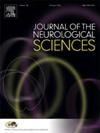Reversible rituximab demyelination in anti-MAG polyneuropathy: A role for IVIG?
IF 3.2
3区 医学
Q1 CLINICAL NEUROLOGY
引用次数: 0
Abstract
Background and aims
Anti-myelin-associated glycoprotein (MAG) demyelinating neuropathy is a clinically heterogeneous slowly progressive large fiber sensorimotor polyneuropathy. Management of anti-MAG neuropathy is challenging, and a small subset of anti-MAG neuropathy patients have been previously reported to deteriorate after rituximab therapy, perhaps triggered by an upsurge in autoantibody release secondary to B lymphocyte lysis. We report a patient with this complication that responded to IVIg therapy.
Method
Case description and serial electrophysiological studies.
Results
Serial electrophysiological studies confirmed subacute demyelination in our patient with anti-MAG neuropathy treated with rituximab followed by improvement following IVIg.
Interpretation
The use of IVIG therapy can be considered in cases where rituximab leads to clinical and electrophysiological worsening of anti-MAG neuropathy.
抗mag多神经病变可逆利妥昔单抗脱髓鞘:IVIG的作用?
背景与目的抗髓鞘相关糖蛋白(MAG)脱髓鞘神经病是一种临床异质性缓慢进展的大纤维感觉运动多神经病变。抗mag神经病变的管理是具有挑战性的,以前有报道称一小部分抗mag神经病变患者在接受利美昔单抗治疗后病情恶化,这可能是由于B淋巴细胞溶解后自身抗体释放的增加引起的。我们报告一例对IVIg治疗有反应的并发症患者。方法病例描述和连续电生理研究。结果一系列电生理研究证实,我们的抗mag神经病变患者接受利妥昔单抗治疗后出现亚急性脱髓鞘,IVIg治疗后病情有所改善。在利妥昔单抗导致抗mag神经病变的临床和电生理恶化的情况下,可以考虑使用IVIG治疗。
本文章由计算机程序翻译,如有差异,请以英文原文为准。
求助全文
约1分钟内获得全文
求助全文
来源期刊

Journal of the Neurological Sciences
医学-临床神经学
CiteScore
7.60
自引率
2.30%
发文量
313
审稿时长
22 days
期刊介绍:
The Journal of the Neurological Sciences provides a medium for the prompt publication of original articles in neurology and neuroscience from around the world. JNS places special emphasis on articles that: 1) provide guidance to clinicians around the world (Best Practices, Global Neurology); 2) report cutting-edge science related to neurology (Basic and Translational Sciences); 3) educate readers about relevant and practical clinical outcomes in neurology (Outcomes Research); and 4) summarize or editorialize the current state of the literature (Reviews, Commentaries, and Editorials).
JNS accepts most types of manuscripts for consideration including original research papers, short communications, reviews, book reviews, letters to the Editor, opinions and editorials. Topics considered will be from neurology-related fields that are of interest to practicing physicians around the world. Examples include neuromuscular diseases, demyelination, atrophies, dementia, neoplasms, infections, epilepsies, disturbances of consciousness, stroke and cerebral circulation, growth and development, plasticity and intermediary metabolism.
 求助内容:
求助内容: 应助结果提醒方式:
应助结果提醒方式:


